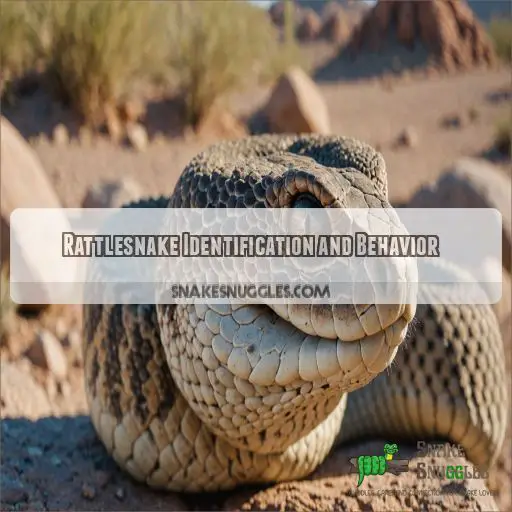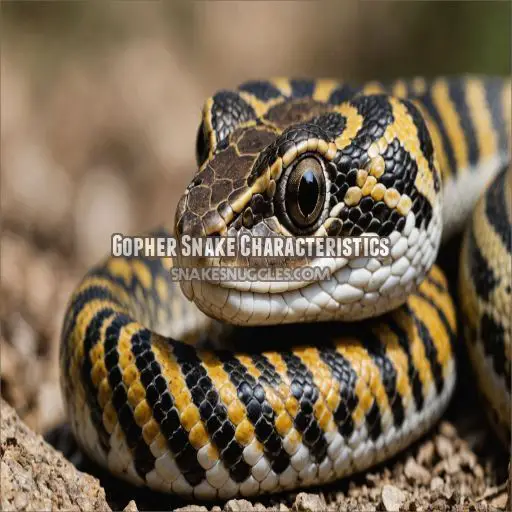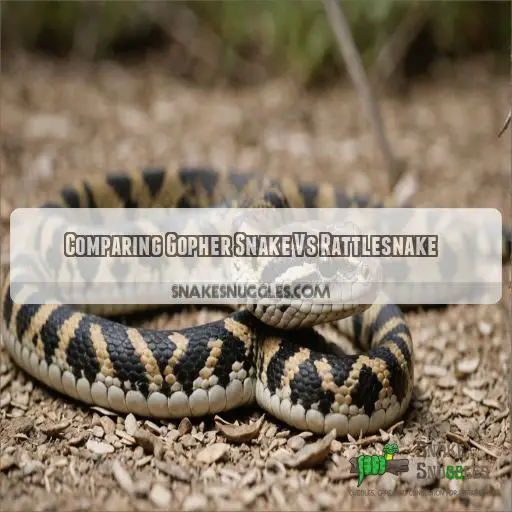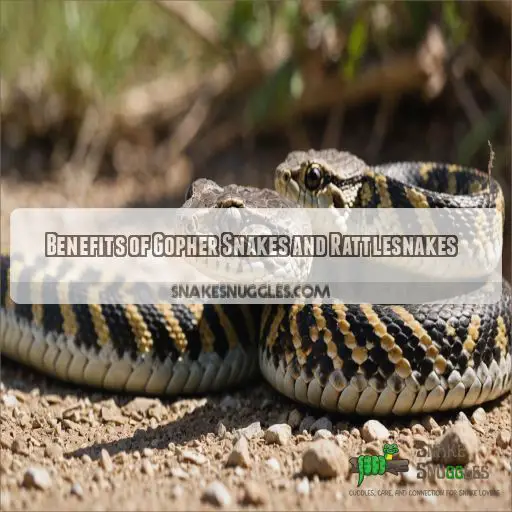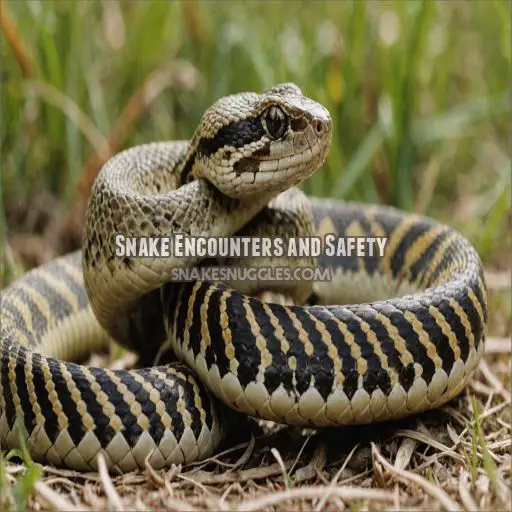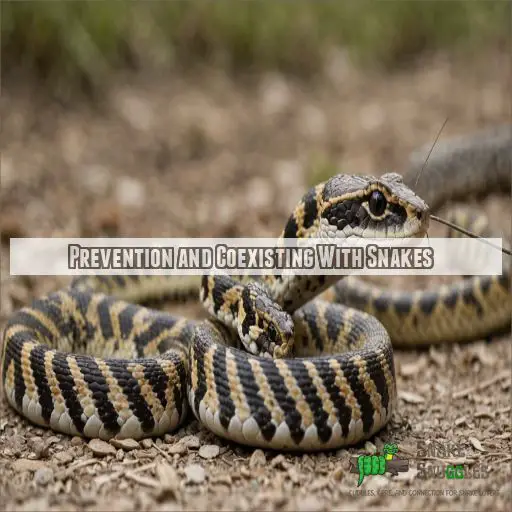This site is supported by our readers. We may earn a commission, at no cost to you, if you purchase through links.
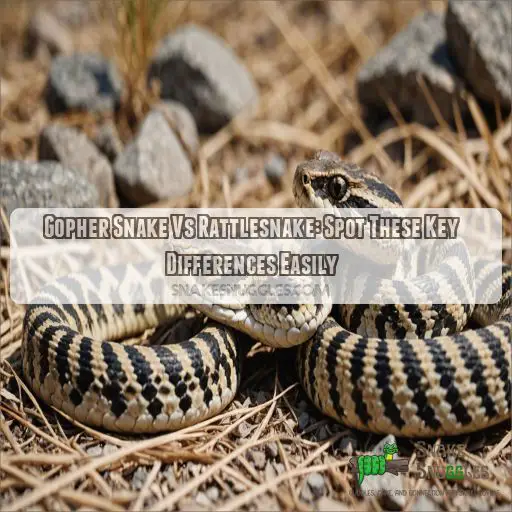
If its round like a marble, you’re eyeing a gopher snake.
But a triangular, diamond-shaped head? That’s a rattlesnake, loaded with venom and keen to rattle.
Eye pupils spill more secrets: round for gophers, vertical slits for rattlers.
And don’t forget the tail—only rattlesnakes have that iconic, attention-grabbing rattle.
Gopher snakes might impersonate rattlers by shaking their tails, but the lack of actual rattles gives them away.
Intrigued by the serpentine showdown? There’s plenty more insights slithering ahead!
Table Of Contents
- Key Takeaways
- Gopher Snake Vs Rattlesnake
- Rattlesnake Identification and Behavior
- Gopher Snake Characteristics
- Comparing Gopher Snake Vs Rattlesnake
- Benefits of Gopher Snakes and Rattlesnakes
- Snake Encounters and Safety
- Prevention and Coexisting With Snakes
- Frequently Asked Questions (FAQs)
- How can you tell the difference between a gopher snake and a rattlesnake?
- Do gopher snakes eat rattlesnakes?
- What snake can be mistaken for a rattlesnake?
- What happens if a gopher snake bites you?
- How do gopher snakes defend against predators?
- Are rattlesnakes active during the day?
- Do gopher snakes have a preferred habitat?
- Can rattlesnakes climb trees like gopher snakes?
- What is the lifespan of a gopher snake?
- Conclusion
Key Takeaways
- When comparing a gopher snake and a rattlesnake, you’d want to start by checking their head shapes. Gopher snakes have rounded heads, while rattlesnakes flaunt a triangular, venom-loaded noggin. It’s like comparing an apple to a triangle.
- Keep an eye on those peepers. Gopher snakes sport round pupils, perfect for daylight vision, whereas rattlesnakes have those classic vertical slits, giving them a cool-cat look for night missions.
- Don’t get fooled by a tail wag – gopher snakes might shake it like a rattlesnake, but they lack the real rattle. Think of it as them auditioning for a maraca band without the instruments.
- Both snakes are nature’s pest controllers, helping farmers and ecosystems by gobbling up rodents, though with different methods – constriction for gopher snakes and venomous strikes for rattlesnakes. It’s like a pest control double act without the bill.
Gopher Snake Vs Rattlesnake
Telling a gopher snake from a rattlesnake can be tricky, like choosing between your favorite snacks.
But with a keen eye, you can spot key traits that reveal their true identity.
Look for differences in body shape, head features, and tail details.
You won’t be caught shaking in your boots!
Key Differences in Body Shape
At first glance, noticing the contrasting gopher snake build versus rattlesnake thickness can be tricky.
- Snake Body Length: Gopher snakes are typically more elongated.
- Sleek vs. Stout: Rattlesnakes tend to have a robust form.
Gopher Snake: Long and slender.
Distinct Head Shapes and Facial Pits
Distinguishing gopher snakes from rattlesnakes starts with their heads.
Gopher snakes have rounded, non-venomous heads, while rattlesnakes boast triangular, venom-filled heads with heat-sensing facial pits below their eyes.
| Feature | Gopher Snake | Rattlesnake |
|---|---|---|
| Head Shape | Rounded | Triangular |
| Facial Pits | Absent | Present |
| Venom Glands | Absent | Present |
Identifying Features in the Tail
Speaking of heads, have you noticed the tail?
Gopher snakes flaunt a sleek, tapered tail without a flicker of a rattle.
Picture a sassy handshake.
Meanwhile, rattlesnakes sport a distinct, stubby tail with a telltale rattle – it’s nature’s maraca!
Differences in Eyes and Pupils
While the tail differences are striking, snake eyes tell another tale.
Rattlesnakes have cat-like, vertical pupils suited for night hunting, like detectives in shady alleyways.
Meanwhile, gopher snakes sport round pupils, perfect for daytime vision.
Their snake pupils say it all!
Rattlesnake Identification and Behavior
You might not want to invite rattlesnakes to a picnic, but understanding their unique traits can make spotting them easier.
Rattlesnakes are known for their famous rattles and sneaky ambush tactics.
These reptiles are the silent hunters of the wild, using special heat-sensing pits to track down unsuspecting prey.
Unique Rattles and Hunting Styles
Rattlesnakes have a distinctive rattle on their tail, which they shake as a warning when threatened.
They are ambush predators, lying in wait to strike unsuspecting prey with their potent venom.
Gopher snakes mimic this behavior, but lack the rattle, which they shake to mimic a rattlesnake.
Rattlesnakes as Ambush Predators
Imagine a silent, scaly ninja lurking among rocks.
Rattlesnakes camouflage themselves at their finest.
These sly predators excel in ambush tactics, waiting patiently before their lightning-fast strike.
They carefully select prey, using venom delivery for a quick meal.
Stay safe by learning snake bite prevention.
Importance of Heat-Sensing Pits
Rattlesnakes don’t just wait; they hunt with precision, thanks to heat-sensing pits.
These amazing features help snake species like Crotalus oreganus oreganus detect prey even in the dark.
It’s like having night vision goggles to locate rodent snacks effortlessly!
Common Places to Find Rattlesnakes
Rattlesnakes use heat-sensing pits to help them hunt.
Knowing where they live can help keep you safe.
Look out for them in desert areas, rocky terrain, grasslands, and wooded places.
Gopher Snake Characteristics
Gopher snakes are the sleek, golden-tan superheroes of the snake world.
They have handsome blotched patterns and the ability to mimic rattlesnakes by vibrating their tails.
These harmless critters are a farmer’s best friend, helping control pesky rodent populations.
Sleek Body and Handsome Patterns
Gopher snakes have intriguing characteristics.
Their sleek bodies and golden-tan coloring, adorned with handsome blotched patterns, provide excellent camouflage.
This natural artistry highlights their role in the ecosystem’s intricate dance.
Mimicry and Vibrating Tails
In terms of outwitting predators, gopher snakes are cunning little mimics.
Their vibrating tails can trick you into thinking they’re rattlesnakes.
Here’s how they do it:
- Predator deception.
- Snake evolution.
- Clever use of rattlesnake defense.
Gopher Snake Hunting Habits
Switching gears from mimicry, let’s explore gopher snake hunting habits.
These slippery diurnal hunters use savvy techniques to snag prey.
They have keen eyes for rodent hotspots, with seasonal variations favoring warmer months.
Snake ecology fans, appreciate their role in natural management!
Diet and Importance in Agriculture
Gopher snakes are excellent natural pest control.
They feast on gophers, mice, rats, and other rodents that can wreak havoc on crops.
Their presence benefits farmers by reducing agricultural damage and minimizing the need for harmful pesticides.
Comparing Gopher Snake Vs Rattlesnake
You’re out on a hike and spot a snake slithering nearby.
How do you know if it’s a gopher snake or a rattlesnake if you see one in your yard??
With a keen eye for details like body length, colors, tail, and the presence or lack of a rattle, you’ll be able to identify your serpentine companion without getting too rattled!
Overall Length and Build
Diving into snake length variations, you’ll notice gopher snakes can stretch like a yoga instructor, reaching impressive lengths.
Gopher snakes are longer than rattlesnakes.
Rattlesnakes, although more muscular in build, are shorter.
This build difference helps with identifying and understanding snake bite risks.
Body Color Patterns and Shapes
Just like comparing apples to oranges, gopher snake patterns differ from rattlesnake camouflage like those found on the Eastern Diamondback.
Gopher snakes sport rich golden-tan hues with handsome blotches.
Meanwhile, rattlesnakes wear subtle, earthy tones for perfect snake markings.
Both adapt cleverly as warmer weather warms things up.
Tail Shapes and Rattle Presence
Rattlesnakes have a distinct rattle at the end of their tails.
Gopher snakes have a long, tapered tail.
This key difference helps you easily distinguish between these two snakes when they are slithering by.
Venom and Killing Styles
Rattlesnakes and gopher snakes have distinct differences, particularly in their hunting methods.
While gopher snakes rely on constriction to subdue their prey, rattlesnakes utilize venom.
Rattlesnakes deliver their venom, which can be potent, leaving prey with a second thought about their choices before becoming a meal.
Benefits of Gopher Snakes and Rattlesnakes
You might not think of snakes as helpful, but both gopher snakes and rattlesnakes play key roles in the ecosystem.
Gopher snakes are the farmers’ friends, munching on pesky rodents.
Rattlesnakes keep the wild rodent populations in check, proving that sometimes, scary-looking neighbors are the best allies!
Roles in the Ecosystem and Agriculture
While snakes aren’t everyone’s cup of tea, gopher snakes and rattlesnakes are valuable allies in rodent control.
They keep the predator-prey balance in check.
So, supporting snake conservation helps natural pest control, benefiting ecosystems and agriculture alike.
Gopher Snake Benefits for Farmers
Gopher snakes are a farmer’s best friend.
They gobble up pesky rodents that can wreak havoc on crops.
Their appetite for gophers, mice, and other agricultural pests makes them invaluable natural pest control allies.
Importance of Rattlesnakes in the Wild
As gopher snakes benefit farmers, let’s chat about rattlesnakes.
These slithery guardians help maintain ecosystem balance by controlling rodent populations.
Their venom, surprisingly useful, plays a key role in medical research, highlighting their contribution beyond initially rattling encounters.
Conservation Status and Threats
Now, let’s talk conservation!
Rattlesnakes and gopher snakes face habitat loss and climate change, which are known threats to bullsnake populations. which are known threats to bullsnake populations.
Human interaction, often less than friendly, contributes to their threats.
Overhunting for snake venom doesn’t help either.
They need your understanding to thrive amidst these challenges.
Snake Encounters and Safety
Spotting a snake from a distance might send your heart racing.
Knowing the difference between a gopher snake and a rattlesnake can make all the difference.
Let’s explore how to stay safe and calm, even if your day has taken a reptilian twist!
How to Identify a Snake From a Distance
How can you spot a snake from afar?
Look for its distinctive body shape.
Look for its head profile.
Look for its tail movements.
These clues can help you identify it safely before getting too close.
Rattlesnake Encounters and Safety Precautions
Spotting a snake from a distance is one thing, but encountering a rattlesnake up close can be nerve-wracking.
Rattlesnakes usually avoid humans.
If you spot one, just keep calm, avoid sudden movements, and stay safe.
What to Do During a Gopher Snake Encounter
Encountering a gopher snake? You’re in for a treat!
These non-venomous beauties are like nature’s pest control experts.
Observe from a respectful distance, marvel at their hunting skills, and remember: they’re more interested in mice than mingling with you!
Snake Repellents and Yard Maintenance
After a gopher snake’s harmless antics, let’s make sure your yard isn’t a snake hotel. Embrace a snake-free space:
- Natural Repellents: Use sulfur or clove oils.
- Rodent Control: Eliminate snake snacks.
- Yard Cleanup: Declutter hiding spots.
Prevention and Coexisting With Snakes
Keeping your yard clean and sealing up any gaps around your home are key steps to prevent snakes from taking up residence, especially during rattlesnake emergence times.
You can also control rodents, which are a major food source for snakes.
Keeping Rodents Under Control
To rodent-proof your home, consider natural repellents and some effective trapping methods.
A neat yard often keeps pests perplexed and away.
Embrace the predator benefits of gopher snakes.
Snakes may stick around, but so will peace of mind.
Sealing Gaps and Cleaning Up Yards
While keeping rodents under wraps, don’t forget yard maintenance.
Seal gaps in your foundation and tidy up.
A clean yard discourages snake visits; think of it as rolling out a "no thanks" mat, keeping your space tidy and reptile-resistant.
Using Natural Repellents and Barriers
Snakes making you jittery? Use these natural barriers and repellents to keep them at bay:
Natural Barriers
- Create gravel pathways; snakes find them uncomfortable.
- Install mesh fencing.
Natural Repellents
- Plant marigolds; snakes dislike their smell.
- Spread garlic in target areas.
Stay snake-free!
Living Harmoniously With Snakes
Embrace snakes as neighbors, not foes. Cultivate a snake-friendly yard with native plants, rock piles, and water sources. Understand their behaviors to coexist safely. Avoid harming or removing them unless absolutely necessary. Snakes play important roles in our ecosystems.
Snake-Friendly Landscaping
- Provide shelter and food sources
- Use native plants and natural mulch
Snake Myths Debunked
- Snakes aren’t aggressive by nature
- Snakes don’t actively seek out humans
- Recognize defensive postures and avoid startling them
- Understand their hunting and breeding cycles
Frequently Asked Questions (FAQs)
How can you tell the difference between a gopher snake and a rattlesnake?
Better safe than sorry: To distinguish a gopher snake from a rattlesnake, check their pupils, tails, and heads.
Rattlesnakes have cat-like eyes, stubby tails with rattles, and triangular heads.
Gopher snakes have round pupils and pointed tails.
Do gopher snakes eat rattlesnakes?
You might say gopher snakes occasionally dabble in fine dining, as they can eat rattlesnakes.
They’ve got a diverse palate that includes insects, lizards, and small animals.
This makes them both competitive and resourceful hunters in the wild.
What snake can be mistaken for a rattlesnake?
If you’re talking about snakes in disguise, the gopher snake takes the cake.
It’s often mistaken for a rattlesnake because it flattens its head and vibrates its tail.
But it’s harmless and non-venomous.
What happens if a gopher snake bites you?
A gopher snake bite is harmless and feels like a pinch.
These non-venomous snakes lack fangs and venom, so aside from mild irritation, you’re safe.
Cleaning the bite might sting a bit, but that’s it!
How do gopher snakes defend against predators?
Gopher snakes are masters of camouflage, blending seamlessly into their surroundings to avoid predators.
They are known for their impressive defensive tactics, including coiling, hissing, and even vibrating their tails to mimic a rattlesnake.
This display of intimidation effectively scares off potential attackers.
Are rattlesnakes active during the day?
Rattlesnakes are mainly nocturnal, preferring to hunt at night when it’s cooler.
During cooler months, they might bask in the sun or hunt during the day.
It’s always best to watch your step when exploring!
Do gopher snakes have a preferred habitat?
Imagine gopher snakes as nature’s eccentric interior designers.
They favor open habitats like grasslands, farmlands, and semi-deserts.
They thrive where there’s plenty of space to slither and stalk prey.
But they’re quite adaptable and not overly picky.
Can rattlesnakes climb trees like gopher snakes?
Believe it or not, despite their fearsome reputation, rattlesnakes generally avoid tree climbing.
They’re more grounded creatures, preferring the dusty earth.
Gopher snakes, on the other hand, are quite the adventurers and can slither up trees if needed.
What is the lifespan of a gopher snake?
Imagine a gopher snake living its best life for 15 to 20 years in the wild.
These slithery charmers thrive with proper habitat and diet.
They play key roles in ecosystems while avoiding pest problems and human conflicts.
Conclusion
Imagine you’re hiking and spot a snake slithering nearby.
Before you panic, remember the key differences between a gopher snake and a rattlesnake.
Observe its head shape or listen for a rattle to make an accurate ID.
Recognizing these traits helps you feel more confident outdoors and helps protect these beneficial reptiles.

